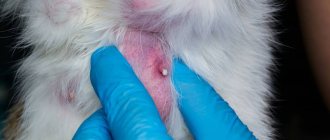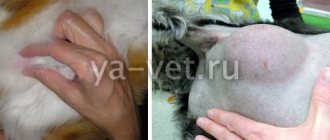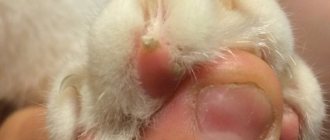Violation of living conditions and improper feeding can provoke numerous diseases of internal organs in cats. One of these pathologies is kidney failure, which if left untreated can lead to death.
We will learn how to recognize the first alarming symptoms of the disease in order to contact a veterinarian in time and prevent the development of complications.
What is kidney failure in cats?
Renal failure in cats is a complete or partial impairment of kidney function. The pathology is accompanied by the death of parenchyma cells in the affected organs, followed by difficulty in removing metabolic products from the animal's body.
The disease affects representatives of all breeds and ages and has a variety of causes and clinical signs. This greatly complicates diagnosis at an early stage of its development.
What cat breeds are predisposed to the disease?
Although kidney failure affects all breeds, it is most common in Maine Coons, Bobtails, Abyssinians, Angoras and Persians.
In addition to breed predisposition, there are other risk factors that can trigger the occurrence of renal pathology.
These include:
- diabetes;
- acute and chronic liver diseases;
- inflammation of the pancreas;
- sudden jumps in blood pressure;
- pathologies of the cardiovascular system;
- imbalance of electrolytes in the blood.
Sometimes kidney failure in a cat occurs against the background of a fever, which often leads to severe dehydration.
Stages of chronic renal failure according to IRIS
- stage: creatinine less than 140 mmol/l, SDMA less than 14, blood pressure less than 150/95 mmHg.
- stage: creatinine 140-249 mmol/l, SDMA 14-25, blood pressure 150-159/95-99 mmHg.
- stage: creatinine 250-439 mmol/l, SDMA above 25, blood pressure 160-179/100/119 mmHg.
- stage: creatinine more than 440 mmol/l, SDMA above 45, blood pressure above 180/120 mmHg.
Determination of the stage and prognosis of the disease is carried out only in a stable patient.
Substages of chronic renal failure:
- Non-proteinuric less than 0.2 protein
- Borderline proteinuric 0.2–0.4 protein
- Proteinuric more than 0.4 protein
Acute renal failure in cats
AKI is a serious disease with rapid development of symptoms that requires immediate treatment of the cat in a clinic. At the initial stage, this process is reversible. It is accompanied by a sharp accumulation of toxic substances with changes in the electrolyte and acid-base balance in the cat’s body.
These disorders provoke the development of complications from the cardiovascular system, cause nervous disorders, vomiting, diarrhea and bleeding.
Veterinary specialists distinguish 3 types of acute renal failure in cats, depending on the cause of the pathology.
Prerenal or prerenal failure
This form of the disease in cats occurs against the background of a sharp decrease in the volume of blood that passes through the renal tubules. This occurs after a significant decrease in blood pressure, which can be caused by the following reasons:
- infectious processes;
- poisoning;
- heat and sunstroke;
- extensive burns;
- shock due to the wrong choice of drug for general anesthesia;
- uncontrollable diarrhea and vomiting;
- severe dehydration of the body;
- significant blood loss;
- acute heart failure;
- traumatic shock resulting from significant tissue damage.
Note! The prerenal form of renal failure in cats occurs without damage to the renal parenchyma, so with proper treatment the process is completely reversible.
Prerenal renal failure in cats manifests itself:
- significant decrease in blood pressure;
- a decrease in body temperature below normal (in the presence of infectious processes, the temperature may rise);
- refusal of food;
- thirst;
- vomiting that does not bring relief;
- changes in the odor of urine and exhaled air (an admixture of acetone appears);
- nervous phenomena;
- severe oppression and apathy.
If the liver, heart or brain is involved in the pathological process, as well as if more than 15% of fluid in the body is lost, veterinarians give an unfavorable prognosis.
Renal or renal failure
Kidney failure in cats is characterized by damage to the structural units of the organ as a result of the following factors:
- bacterial and viral infections;
- drug overdose;
- snake bites;
- blockage of the renal tubules by free hemoglobin due to mass death of red blood cells (toxoplasmosis, poisoning with hemolytic agents, sepsis);
- ingestion of heavy metal salts, aniline and its derivatives;
- inflammatory processes in the renal tubules.
Signs of kidney failure in cats can be nonspecific. These include:
- lethargy;
- digestive disorders;
- swelling;
- tachycardia;
- lack of appetite.
Characteristic symptoms of kidney failure in cats are a decrease in the amount of urine excreted with the appearance of blood in it.
Important! If the cat is completely unable to urinate, it should be urgently sent to a veterinary clinic. In this case, only timely treatment can save the animal’s life.
Veterinarians give a cautious prognosis for a cat's life, depending on the severity of kidney failure.
Postrenal or postrenal failure in cats
Postrenal insufficiency occurs due to compression or blockage of the urinary organs. The cause may be malignant or benign neoplasms, as well as urolithiasis.
The most characteristic clinical signs of post-renal failure are:
- severe pain syndrome, which is accompanied by loud or plaintive meowing, anxiety, and unnatural body position;
- difficulty urinating or its complete absence;
- pallor of visible mucous membranes;
- intoxication (vomiting, diarrhea, muscle tremors, increased temperature).
With timely restoration of urine outflow in the kidneys, irreversible changes do not have time to form. Therefore, the prognosis of treatment can be favorable or cautious. But if the symptoms indicate that the cat's kidneys are failing, there is a high likelihood of complications developing.
Symptoms of disorders
Characteristic signs appear only when more than 70% of tissues are affected. Most often, the disease is diagnosed in animals older than 8 years. Because of this, the first non-obvious symptoms (loss of activity and appetite) are attributed to old age. As the patient’s condition worsens, the symptoms are supplemented by:
- the appearance of an ammonia odor from the mouth and drooling;
- blanching of mucous membranes;
- increased thirst and increased frequency of urination up to 10 times a day (the norm for healthy pets is no more than 3 times);
- periodic temperature fluctuations up or down from normal;
- swelling of the paws, chest and abdomen.
Lack of appetite leads to sudden weight loss. The cat's fur becomes dull and his belly sinks. The ribs become visible to the naked eye. Due to frequent trips to the toilet, the hair on the perineum does not have time to dry. The pet constantly licks itself to get rid of droplets of urine.
With more serious violations, new signs appear:
- unsuccessful visit to the tray;
- alternating diarrhea and constipation interspersed with blood in the stool;
- frequent bloody vomiting;
- severe dehydration, expressed in dry mucous membranes;
- increased blood pressure, which threatens blindness due to rupture of blood vessels in the eyeballs;
- isolated muscle twitching and epileptic seizures.
If you notice any of these symptoms, contact your veterinarian immediately. The later the diagnosis is made, the less chance of a favorable prognosis. If the organ fails completely, the animal falls into a coma and dies.
Chronic renal failure
Chronic kidney disease in cats is a dangerous condition in which irreversible processes slowly occur in the affected organs. Healthy parenchyma is gradually replaced by scar tissue, which is unable to perform the function of removing decay products.
As a compensatory mechanism, the animal's body begins to eliminate toxins through the lungs, mucous membranes and gastrointestinal tract. But some toxic substances remain in the blood, they accumulate and negatively affect all organs and systems. This condition can cause the cat's premature death.
Stages of the disease
Veterinary specialists distinguish 4 stages of chronic renal failure in cats, but in most cases, clinical symptoms of the disease are detected only in the third and last.
Latent stage. At this stage, irreversible processes begin in the kidneys that do not manifest external signs and can be accidentally discovered during laboratory examinations.
Initial stage. Over the course of several months, the cat's appetite gradually decreases, dry skin appears, and vomiting occurs periodically.
Typically, owners do not pay attention to these warning signs and attribute them to physiological reasons.
Conservative stage. The first characteristic signs appear when 65% of the volume of kidney tissue is affected. The animal clearly shows a depressed state, the daily amount of urine excreted increases, and periodic vomiting and diarrhea are observed. Sometimes, with chronic kidney pathologies in cats, streaks or blood clots appear in the feces, which indicate the severity of the disease.
Terminal stage. At this stage, cats exhibit symptoms of the following pathologies:
- hypocalcemia (increased excitability and tactile sensitivity, disorientation in space, convulsions, shortness of breath, gastrointestinal disorders);
- uremic encephalopathy (claudication, severe pain, stiffness of movement, convulsions);
- hyperphosphatemia and hyperparathyroidism (pathological fractures, nervous disorders, anorexia, deterioration of the skin and coat, retinal hemorrhages);
- uremic acidosis (loud deep breathing, vomiting, anorexia).
Important! A very clear clinical sign of end-stage renal failure in animals is self-mutilation. This is due to the development of paresthesia, when the cat experiences spontaneous sensations of itching, burning or the presence of blood-sucking parasites on the body.
If an animal comes to the clinic at the last stage of the disease, then veterinary specialists in most cases give an unfavorable prognosis.
Causes and provoking factors for the development of the disease
There are several causes for the development of CKD in cats. Among them are:
- urolithiasis disease;
- polycystic kidney disease;
- congenital developmental anomalies;
- benign and malignant tumors;
- systemic diseases (amyloidosis, gout, diabetes mellitus);
- poisoning with drugs and mercury vapor;
- chronic inflammatory processes in the kidneys.
Owners should be aware that long-term use of antibiotics or analgesics, as well as significantly exceeding their dosage, can provoke chronic renal failure in cats.
Signs and Symptoms of Kidney Failure in Cats
Although the symptoms of chronic renal failure differ depending on the stage of development of the disease, there are basic signs of dysfunction of the urinary system.
These include:
- decreased and lack of appetite;
- the appearance of acetone or ammonia odor from the mouth;
- thirst;
- frequent urination;
- pallor or yellowness of visible mucous membranes;
- vomit.
Note! With chronic renal failure, cats develop small ulcers in their mouths, and tartar also forms very quickly.
In the later stages, signs of dehydration, intoxication and nervous phenomena become noticeable. The amount of urine decreases sharply. The animal may fall into a coma.
Analysis data
To develop a treatment regimen for renal failure in cats, a veterinarian must have laboratory data on the composition of the animal’s blood and urine.
To determine the stage of disease development, the main blood indicator is the creatinine level.
| Stage name | Creatinine level |
| Initial | Up to 250 µmol/l |
| Conservative | From 252 to 440 µmol/l |
| Terminal | Over 440 µmol/l |
Experts also pay attention to an increase in the following indicators in the blood serum:
- protein;
- amylase;
- urea;
- phosphorus, magnesium, sodium.
In a general blood test, with an increase in the number of leukocytes, hemoglobin decreases significantly.
The diagnosis is confirmed if pathogenic bacteria, renal epithelial cells and a high level of white blood cells are found in the urine.
Diagnostic tests
To accurately determine whether a cat has kidney failure, your veterinarian will need to do a series of diagnostic tests, which include:
- Ultrasound of the kidneys;
- X-ray with contrast agent;
- computed tomography of affected organs.
Note! Kidney CT is the most informative, but at the same time expensive examination. Therefore, it is used only in large clinics where there is appropriate equipment.
The final diagnosis is made on the basis of anamnestic data, ultrasound (radiography) results, laboratory tests of the animal’s blood and urine.
Diagnostics in a veterinary clinic
To confirm the disease and determine its form, the veterinarian examines the patient with a mustache, collects anamnesis and conducts diagnostic tests. The mandatory list includes:
- Analysis of urine
. The diagnosis is confirmed by elevated levels of protein and blood cells. The color of the discharge changes to black or almost transparent. The density of urine decreases and sediment appears. The pH level shifts towards an acidic environment.
- Blood analysis
. The amount of glucose, leukocytes, creatinine and phosphates deviates upward. Lymphocytes, hematocrit, platelets and hemoglobin fall. In chronic renal failure, severe anemia is diagnosed.
- Ultrasound
. The examination shows changes in contour and size, as well as the formation of cysts or other neoplasms.
- X-ray
. Determines the area and extent of damage.
A cat with acute renal failure tolerates palpation painfully. Her kidneys are enlarged and her bladder is full of urine. When the urinary organs rupture, free fluid may enter the peritoneum or subcutaneous tissue.
CRF is confirmed by a noticeable softening of the facial bones, which are left without the required amount of calcium. Ulcers may appear on the tongue.
Treatment methods and prognosis
The main task of a veterinary specialist is to identify the root cause of the development of pathology in a cat. Kidney failure is an incurable disease, so therapeutic measures are aimed at relieving symptoms and the most complete restoration of kidney function.
Treatment of this disease involves not only the use of medications, but also a specific diet and regular preventive examinations.
It is impossible to eliminate an attack of kidney failure in cats at home, so she is admitted to the clinic. The animal is prescribed a strict diet and a set of measures is carried out in order to:
- prevent dehydration;
- restore mineral and acid-base balance;
- relieve signs of intoxication;
- normalize blood pressure;
- support the functioning of the heart muscle;
- eliminate anemia;
- relieve pain syndrome.
Additional treatment includes vitamin therapy to speed up the body's recovery and increase its resistance to disease.
If the cat's condition is severe, hemodialysis is prescribed. This is an intravenous infusion of a mixture of medications that quickly restore the water-salt balance and remove toxins from the animal’s body.
Treatment regimen for acute renal failure in cats
The treatment regimen for acute renal failure in cats includes diagnostic examinations, diet, the use of medications to relieve symptoms of the disease, and medications aimed at eliminating concomitant pathologies.
Sequence of therapeutic measures for acute renal failure:
- detection and elimination of the cause that provoked this pathology;
- elimination of dehydration;
- prevention of hemolysis;
- relieving symptoms of intoxication (in severe conditions - hemodialysis);
- diet prescription;
- restoration of the balance of water, electrolytes and minerals;
- introduction of a complex of vitamins.
Treatment regimen for chronic renal failure
For the treatment of chronic renal failure in animals, the following regimen is used:
- restoration of appetite and development of a special diet;
- maintaining the full functioning of the cardiovascular system;
- normalizing blood pressure levels;
- restoration of water and electrolyte balance in the blood;
- increased hemoglobin levels;
- vitamin therapy.
In case of exacerbation of the chronic form of PN in a cat, hemodialysis is prescribed.
What medications are used
Depending on the symptoms, certain groups of medications are used to treat kidney failure in cats. Their dosage and course duration are determined only by a veterinarian based on the results of a clinical examination, laboratory data and the individual characteristics of the animal’s body.
| Purpose | Drug groups | Drug names |
| Eliminating bacterial infection | Antibiotics | Enrofloxacin, |
| Ciprofloxacin | ||
| Suppressing immune reactions and relieving swelling | Glucocorticoids | Dexamethasone, Methylprednisolone, Prednisolone |
| Relieving swelling, reducing inflammation | Diuretics | Furosemide |
| Prevention of dehydration, restoration of mineral-salt metabolism | Nutrient and rehydration solutions for intravenous administration | Ringer-Locke solution with the addition of 40% glucose solution, Trisol |
| Stopping vomiting (if necessary) | Antiemetics | Metoclopramide, Cerucal, Ondansetron |
| Replenishment of potassium ions | Potassium-containing drugs | Panangin |
| Eliminate constipation and restore normal gastrointestinal function | Laxatives | Duphalac, Lactusan, Bifidum 791 BAG |
| Lower blood pressure | ACE inhibitors | Enalapril, Ramipril |
| Maintaining cardiovascular function | Cardiogenic drugs | Cocarboxylase, Riboxin, Sulphocamphocaine |
| Removing intoxication | Detoxification drugs | Enterosgel, Liarsin, Plasmapheresis, Lespenefril |
| Elimination of anemia, acceleration of the process of hematopoiesis | Hematopoietic drugs | Recormon, Ursoferran, Hemobalance |
| Stop bleeding | Hemostatic drugs | Dicynon, Vikasol |
| Activation of digestion | Enzyme preparations | Ranitidine, Famotidine |
Special diet for kidney diseases
After eliminating the symptoms of chronic or acute renal failure, which may pose a threat to the cat's life, the animal is prescribed a diet using high-quality ready-made cat food or natural products. The duration of the diet is at least 9 months.
The list of prohibited products includes:
- whole milk and dairy products;
- fish fat;
- salt;
- egg yolk.
The amount of meat and fish products should be reduced, and in severe conditions, they should be temporarily excluded from the diet. You should exit the diet gradually, under the supervision of a veterinarian.
Prevention
Kidney failure in cats is a dangerous pathology that can cause the death of the animal if not treated in a timely manner. There is no specific prevention of kidney disease, but you can reduce the risk of their occurrence:
- The pet must be protected from injury, burns and poisoning.
- You should monitor the cat’s diet - the animal is switched to balanced industrial super premium or holistic food.
- It is necessary to carry out regular preventive examinations with a veterinarian.
Recognizing the first symptoms of kidney failure in cats and promptly contacting a veterinary clinic will help stop the pathological process, prevent the development of complications and, possibly, save the animal’s life.










